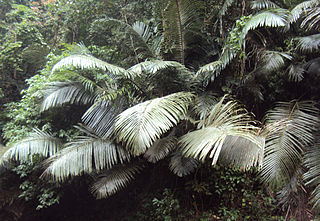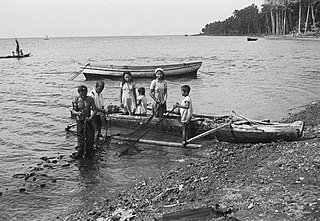
Tapioca is a starch extracted from the tubers of the cassava plant, a species native to the North and Northeast regions of Brazil, but whose use is now spread throughout South America. It is a perennial shrub adapted to the hot conditions of tropical lowlands. Cassava copes better with poor soils than many other food plants.

Sago is a starch extracted from the pith, or spongy core tissue, of various tropical palm stems, especially those of Metroxylon sagu. It is a major staple food for the lowland peoples of New Guinea and the Maluku Islands, where it is called saksak, rabia and sagu. The largest supply of sago comes from Southeast Asia, particularly Indonesia and Malaysia. Large quantities of sago are sent to Europe and North America for cooking purposes. It is traditionally cooked and eaten in various forms, such as rolled into balls, mixed with boiling water to form a glue-like paste (papeda), or as a pancake.

Hainuwele, "The Coconut Girl", is a figure from the Wemale and Alune folklore of the island of Seram in the Maluku Islands, Indonesia. Her story is an origin myth.

Ficus microcarpa, also known as Chinese banyan, Malayan banyan, Indian laurel, curtain fig, or gajumaru (ガジュマル), is a tree in the fig family Moraceae. It is native in a range from China through tropical Asia and the Caroline Islands to Australia. It is widely planted as a shade tree and frequently misidentified as F. retusa or as F. nitida.

Heart of palm is a vegetable harvested from the inner core and growing bud of certain palm trees, most notably the coconut, juçara, açaí palm, palmetto, and peach palm. Harvesting of many uncultivated or wild single-stemmed palms results in palm tree death. However, other palm species are clonal or multi-stemmed plants, and moderate harvesting will not kill the entire clonal palm. Heart of palm may be eaten on its own, and often it is eaten in a salad.

Palm sugar is a sweetener derived from any variety of palm tree. Palm sugar is sometimes qualified by the type of palm, as in coconut palm sugar. While sugars from different palms may have slightly different compositions, all are processed similarly and can be used interchangeably.

Arenga pinnata is an economically important feather palm native to tropical Asia, from eastern India east to Malaysia, Indonesia, and the Philippines in the east. Common names include sugar palm, areng palm, black sugar palm, and kaong palm, among other names.

Cendol is an iced sweet dessert that contains droplets of pandan-flavoured green rice flour jelly, coconut milk and palm sugar syrup. It is commonly found in Southeast Asia and is popular in Indonesia, Malaysia, Brunei, Cambodia, East Timor, Laos, Vietnam, Thailand, Singapore, Philippines, and Myanmar. Next to the green jelly, additional toppings might be added, including diced jackfruit, sweetened red azuki beans, or durian.

Arenga is a genus of palms, native to Southeast Asia, southern China, New Guinea, and northern Australia. They are small to medium-sized palms, growing to 2–20 m tall, with pinnate leaves 2–12 m long. Arenga palms can grow in areas with little sunlight and relatively infertile soil.

Tacca leontopetaloides is a species of flowering plant in the yam family Dioscoreaceae. It is native to Island Southeast Asia but have been introduced as canoe plants throughout the Indo-Pacific tropics by Austronesian peoples during prehistoric times. They have become naturalized to tropical Africa, South Asia, northern Australia, and Oceania. Common names include Polynesian arrowroot, Fiji arrowroot, East Indies arrowroot, pia, and seashore bat lily.

Arenga wightii is a species of flowering plant in the family Arecaceae. It is native to the Southern Western Ghats in Kerala in India. This palm has various uses in its communities. Local tribal communities depend on this plant for starch and religious ceremonies. It is also used to cover the roofs of houses due to its string resemblance to coconut leaves. Scientists have discovered that this palm has medicinal value. It is said to have antimicrobial and antioxidant phytochemicals. It is threatened by habitat loss.

Metroxylon sagu, the true sago palm, is a species of palm in the genus Metroxylon, native to tropical southeastern Asia. The tree is a major source of sago starch.

Papeda, or bubur sagu, is a type of congee made from sago starch. It is a staple food of the people indigenous to Eastern Indonesia, namely parts of Sulawesi, the Maluku Islands and Papua. It is also widespread in Papua New Guinea and serves as the counterpart to central and western Indonesian cuisines that favour rice as their staple food.

Terminalia microcarpa is a tree species in the family Combretaceae. It occurs throughout the Philippines, in parts of Malaysia and Indonesia, Papua New Guinea, possibly the Bismarck Archipelago, and northern Australia. It is cultivated on a small scale in the Philippines, where the edible sweet and tart plum-like fruits are eaten as is or are traditionally made into jams, jellies, and wines.

Sangirese or Sangihe people are one of the native people of the Sangir Islands in the northern chain of islands in Sulawesi and the southern part of Mindanao. The Sangirese people are fishermen and nutmeg growers in their home areas and also work as wage labourers in industrial crops enterprises in Bolaang Mongondow Regency and Minahasa Regency.

A tapioca pearl, also known as tapioca ball, is an edible translucent sphere produced from tapioca, a starch made from the cassava root. They originated as a cheaper alternative to sago in Southeast Asian cuisine. When used as an ingredient in bubble tea, they are most commonly referred to as pearls or boba. The starch pearls are typically five to ten millimeters in diameter. By adding different ingredients, like water, sugar, or some other type of sweetener like honey, tapioca pearls can be made to vary in color and in texture. Various forms of tapioca pearls include black, flavored, popping, mini, and clear. Tapioca pearls are commonly soaked in sugar syrup to make them sweet and chewy. In teas, they are often added for their texture, with the flavor being provided by the drink itself.
Kaong palm vinegar, also known as irok palm vinegar or arengga palm vinegar, is a traditional Filipino vinegar made from the sap of the kaong sugar palm. It is one of the four main types of vinegars in the Philippines, along with coconut vinegar, cane vinegar, and nipa palm vinegar. It is usually sold under the generic label of "palm vinegar".

Sagu is a southern Brazilian dessert, made with tapioca pearls, sugar and red wine. It is typical of the state of Rio Grande do Sul, but also consumed in Santa Catarina and Paraná.

Kue bangkit is a small biscuit in Malay cuisine made from sago starch, commonly found amongst the Malay communities in Brunei, Indonesia, Malaysia and Singapore. This biscuit has various colours, ranging from white, yellowish to brown, depending on the additional ingredients.

Indonesian noodles are a significant aspect of Indonesian cuisine which is itself very diverse. Indonesian cuisine recognizes many types of noodles, with each region of the country often developing its own distinct recipes.


















